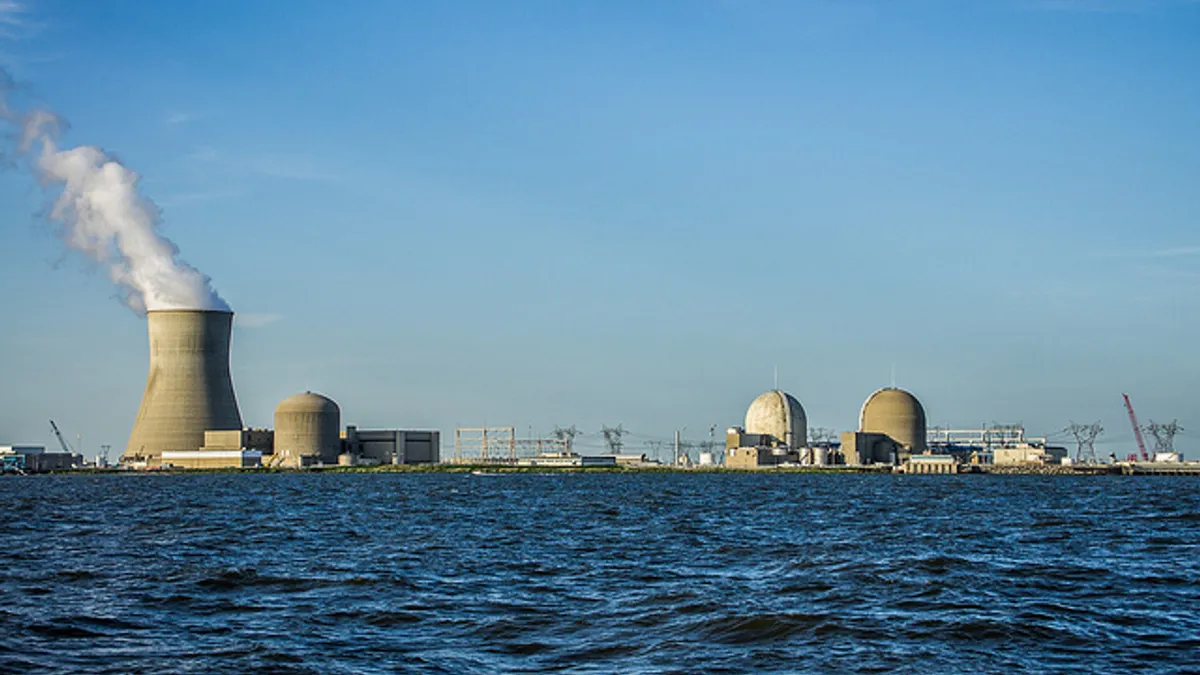Dive Brief:
-
Cold weather caused the shutdown of a generating unit at New Jersey’s Salem nuclear plant early Thursday after ice formed on the screens protecting its water intake, limiting the flow needed to cool the reactor.
-
Plant operator PSE&G told local media Salem's other other unit remained running, but could not estimate when Unit 2 would be back online. Grid operator PJM said regional power demand was lower than expected Thursday, leaving ample reserves to compensate for the forced outage.
-
The incident comes as PSE&G pushes New Jersey regulators to approve subsidies for its nuclear plants and advocates for higher market payments at PJM and the Federal Energy Regulatory Commission (FERC).
Dive Insight:
The outage at PSE&G's Salem plant is an example of the multiple issues cold weather can cause with power generation and delivery.
Last year, Entergy's Pilgrim nuclear plant in Vermont went offline during a cold snap due to a transmission fault. And in past Polar Vortexes, coal operators have seen fuel piles and plant mechanics freeze while gas plants have experienced disruptions to fuel supplies.
This time, the issue at the Salem plant involved so-called frazzle ice that can accumulate on the plant's water intake system during extreme cold. PSE&G told local media outlets the event last occurred in 2010, and Nuclear Regulatory Commission inspectors found no safety issues at the plant.
Salem’s Unit 2 has a capacity of more than 1.1 GW, but PJM’s robust 22% reserve margin and lower than expected demand on Thursday meant the regional grid rode through the winter storm without serious reliability issues.
Even after Salem Unit 2 went offline shortly after 3 a.m. on Thursday, the grid operator said it passed its morning period of peak power demand without incident.
PJM had previously forecast that Thursday could be a record-setting day for power demand, but officials told the Energy News Network that many large manufacturing plants and schools closed because of the weather, keeping demand below 140 GW, as opposed to a forecast of over 143 GW.
Other U.S. grid operators rode out the storm without major incident. The Midcontinent ISO issued a maximum generator alert on Wednesday, warning plant owners not to cease operations due to higher than expected demand and forced outages. But the ISO terminated that request and its emergency cold weather alerts on Thursday night.
In ISO-New England, a Thursday that began with higher than expected power demand gave way to one where solar and other renewable resources overperformed their forecasts, as Boston energy official Joe LaRusso noted on Twitter.
And the sun sets on another cold but sunny day in New England. pic.twitter.com/68NQ6xcJWr
— Joe LaRusso ???? ???????? (@jglarusso) January 31, 2019
While power systems remained reliable through the Polar Vortex, the extreme weather contributed to some disruptions in natural gas supply.
On Wednesday, Michigan utility Consumers Energy urged customers to reduce their gas usage after a fire at a compression station limited fuel supplies during a time of record gas demand. Consumers said customers can return to normal gas consumption Friday night.
In Minnesota, Xcel Energy issued a similar call for gas conservation after cold weather caused "significant" strain on its system, leaving 150 people without gas service. Xcel said Thursday afternoon that residents could return to normal gas usage.
The gas and nuclear issues during the Polar Vortex could impact debates over grid resilience at FERC. In the past coal and nuclear owners have used cold weather incidents to shape arguments for financial assistance.













